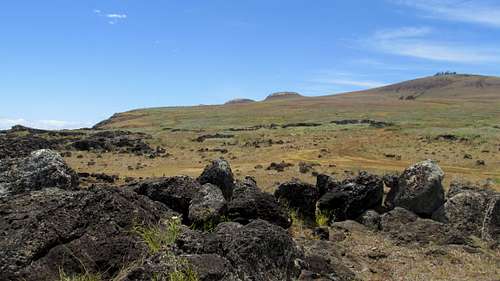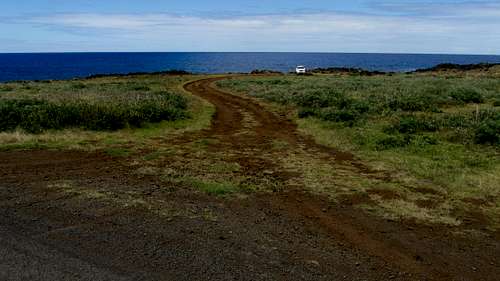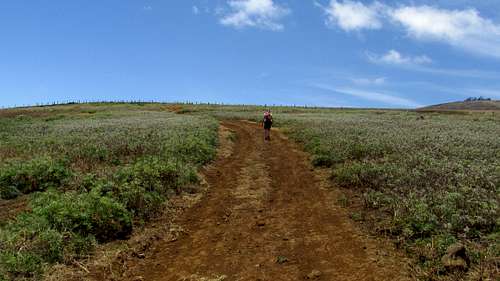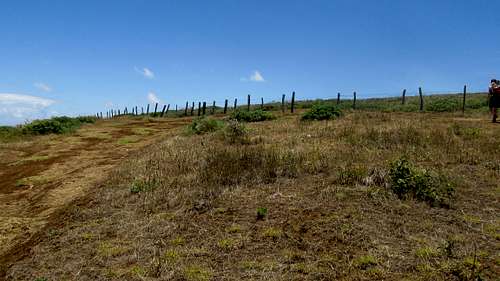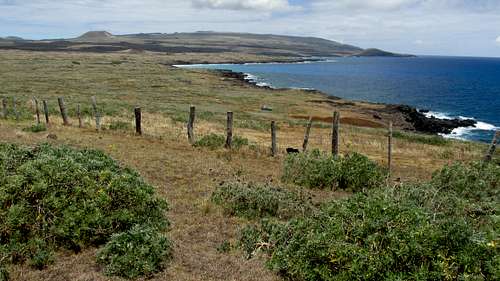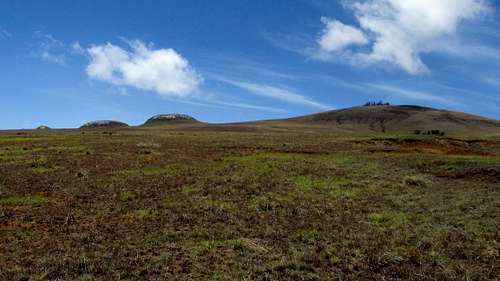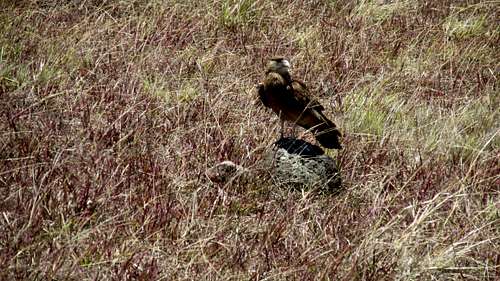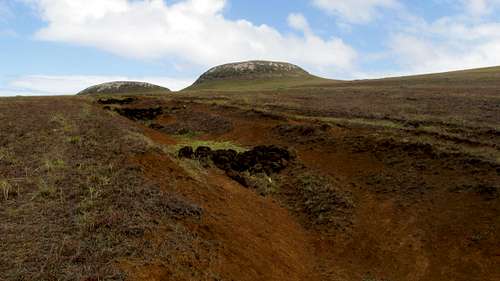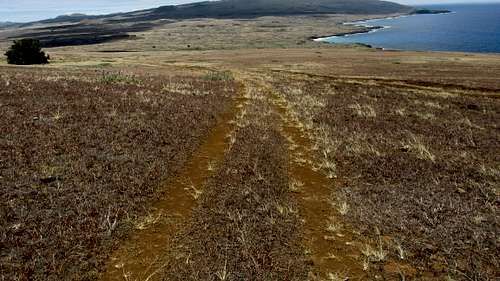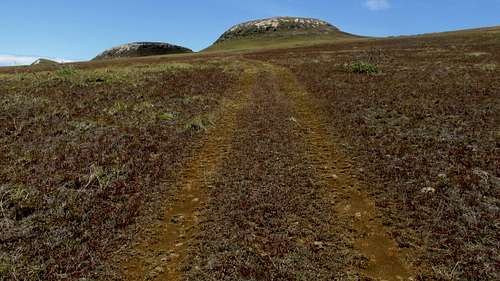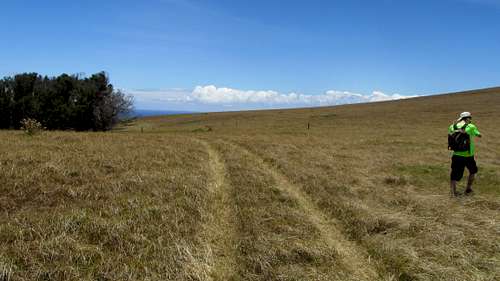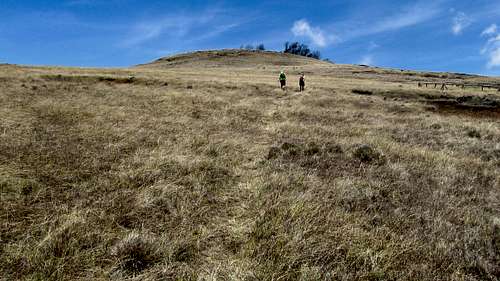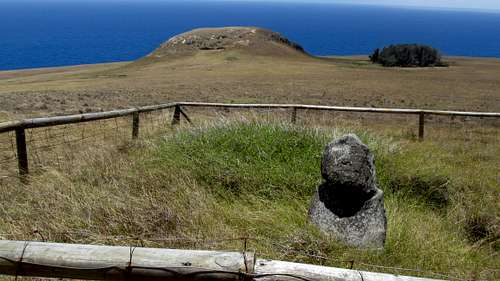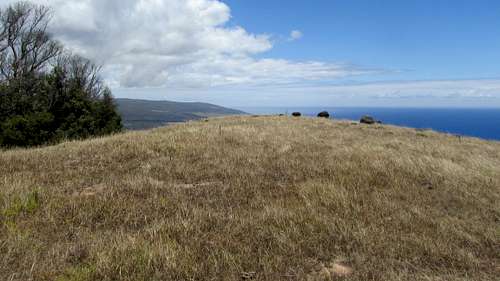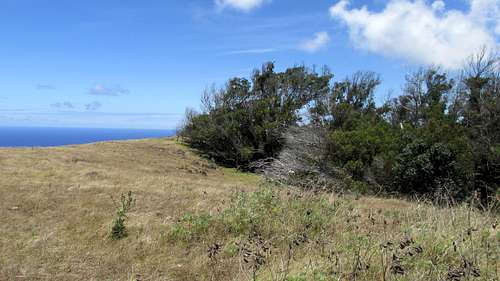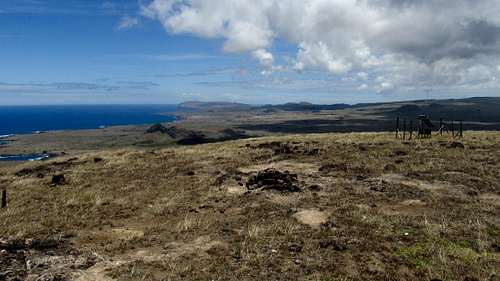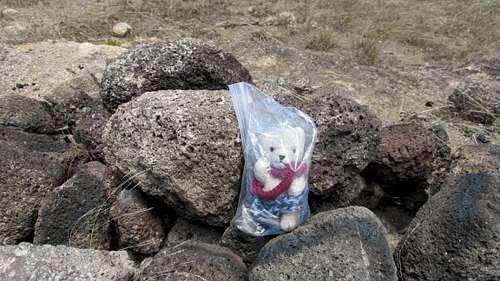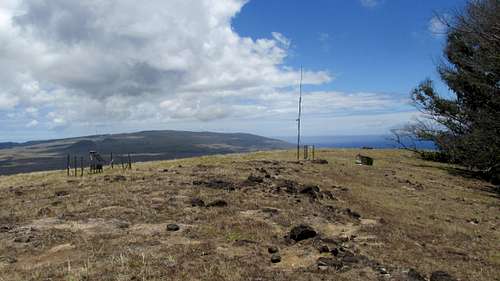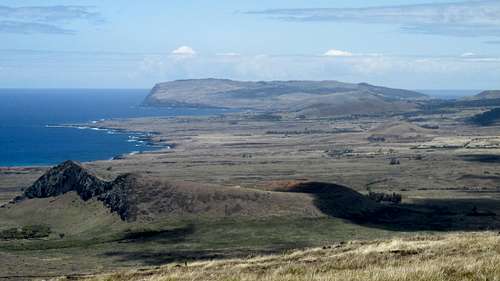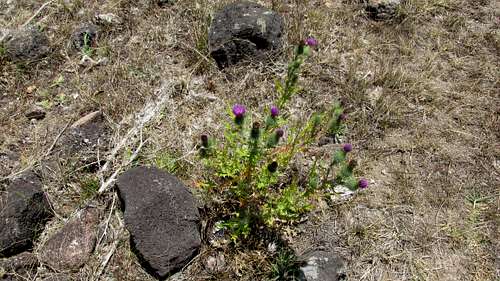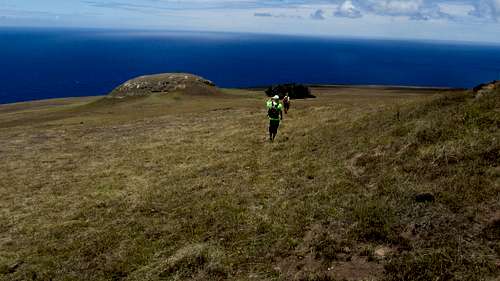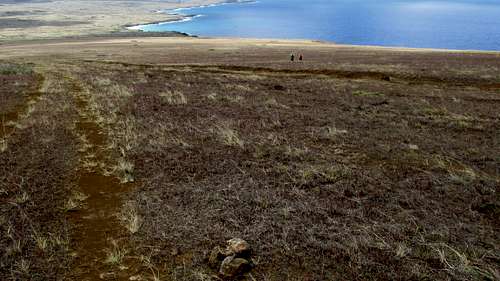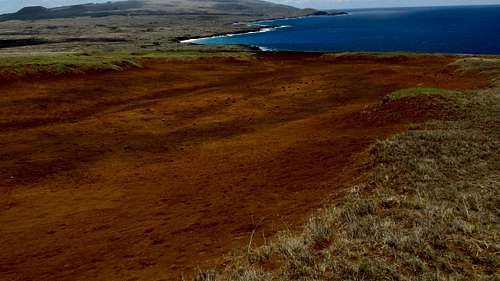-
 1416 Hits
1416 Hits
-
 79.78% Score
79.78% Score
-
 11 Votes
11 Votes
|
|
Route |
|---|---|
|
|
27.10435°S / 109.25068°W |
|
|
Hiking |
|
|
Summer |
|
|
Half a day |
|
|
Class 2 |
|
|
Overview
Muanga Pukatikei is the second highest mountain on Easter Island - Isla de Pascua - Rapa Nui. I see a variety of published elevations on websites and maps. Some indicating the mountain is over 1500’ high. The true height is closer to 1200’ and some change. Both Maunga Terevaka, the highest summit on Easter Island, and Rano Kau with a road leading to the Orongo archaeological site see more visitors.Getting There
While it is possible to walk to both Maunga Terevaka & Rano Kau from Hanga Roa, Maunga Pukatikei is at the other end of the island. We rented a vehicle from Paul at Hotel Tekarera on Christmas Day to do some site seeing and to climb Pukatikei.Route Description
Many maps show a track heading northeast up the mountain from along the road that crosses the island from the south by Ahu Tongariki to the north shore. We saw what was probably that road, but chose instead to head to near where the main road meets the shore on the north side of the island. Just before the road turns west to head across the north side of the island, there is an unpaved road on the right.
The first part of the road was okay for most vehicles, but it quickly became a 4WD road. Fortunately there are wide spots to park with a beautiful view of the rugged shoreline. This is probably the first time I climbed a mountain where the trailhead was right next to the ocean.
After parking the rented Suzuki we started up the road for as far as it would take us. We could see the trees in the summit crater rising above us to the southeast.
It wasn't far before the road ended at a wire fence. We crawled under the fence at a dip in the land.
After the fence the route was simple. We aimed for the saddle between the summit and the row of volcanic cones on the north side of the mountain.
After gaining about 500’ we came across a road. Not a constructed road but one formed by driving on the terrain. This was probably the same road we passed on our way to our trailhead.
This road conveniently headed straight up to the Maunga Vai – Heva saddle.
It continued down the other side a distance unknown to us. The GPS showed the saddle elevation to be 828’. It took us around 50 minutes to come this far.
From here, we made a right turn and headed up a social path towards the summit.
On the way to the summit at around 1000’ is a small moai marked and protected by a fence. We took a few pictures and continued on to the summit.
A direct approach to the crater rim started getting a little steep near the top so we swung a bit to the right. On the first high point of the rim was a couple with a two kids.
After exchanging pleasantries we continued around the crater clockwise until we came to the high point.
The crater has a thick patch of trees and other vegetation growing in it. We stayed on the broad rim without exploring the crater. Whereas we gained the crater rim on the northwest we traveled around to the south to get to the summit marked by a cairn.
There are a couple small antennas on the summit and great views of much of the island. The broad shield volcano Maunga Terevaka, the monarch of Easter Island provides views for most of the hike.
Rano Kau and Rano Raraku line up nicely for a picture.
From the saddle to the summit took a casual 30 minutes. We took our time having a lunch on top and taking pictures while completing the circle of the crater rim.
It took about an hour to hike back down to the trailhead at an easy pace reversing the same route.
As long as it’s clear you shouldn't have any trouble finding your way. Even if there were thick fog, the mountain takes up the eastern peninsula of the island. You would just have to head west to hit the main road. We had great weather our entire time on Easter Island, with only a few light sprinkles.
Essential Gear
The standard advice on Easter Island is to take lots of water and sunscreen! Hiking boots or trekking shoes recommended along with sunglasses and a hat! It's possible the wind might pick up or there will be a shower, so a jacket in case a t-shirt proves not to be enough.Money changing: There are a couple ATMs in Hanga Roa, the only town on the island. We didn’t use them but changed our money at the gas station - PUNA VAI Mini Market - just off the main street on the south side of town. The exchange rate was reasonable and we exchanged on a few occasions. The rate can change daily. The gas station also has a large wine selection! If you have time in Santaigo you can get a better rate there. Downtown in the Central Banking District, on Agustinas between Ahumada & Bandera is a row of Money Changing storefronts with their Buy / Sell rates posted outside. We made it a point to have US dollars in good shape.
Map: Prior to going to Easter Island I ordered the International Travel Maps - Easter Island (Chile). It's a pretty good map with 20 meter contours and a 5 minute grid and 1 minute grid ticks. I used a straight edge to make a one minute grid. I wasn't able to identify the datum. The shift between the map and WGS 84 was mainly in longitude. My GPS has an Easter Island 67 datum that might have been a bit closer than WGS 84 but was still shifted in longitude. On Easter Island I was able to pick up a couple more glossy tourist maps that were also good to have. You will notice inconsistencies between real life and the road / trail patterns on the island. I get the impression the less constructed roads and trails have migrated a bit over the years. There are also contradictions with the elevations between the maps and various websites. This is especially true with Maunga Pukatikei, the volcano that anchors the eastern side of the island. You will also see inconsistency in feature names. Sometimes is English / Spanish / Rapa Nui - Easter Island / Isla de Pascua / Rapa Nui. Other times native names will be broken in different places with or without apparent spelling differences: Pukatikei / Pu a Katiki / Pua Katiki. Have fun!
Weather: We had highs in the 70s and lows in the 60s all week. On a couple occasions there was a light sprinkle. I wore shorts and a tshirt the whole time. Even on the windy mountain tops it never got real cold. Some might want a jacket so it would be prudent to pack one. Sunscreen is a must! A hat for the sun is recommended. I wore trekking shoes on the hikes and they were sufficient. Hiking boots would have been good, especially on Rano Kau. Do not recommend only being in sneakers. There are some places, especially on Rano Kau where the horse grass is tall, the trail isn't established and the surface underneath is rough. There are no water options on the trails. Be sure to pack at least a couple liters, or three liters if you'll be taking a scenic way back!Puka turn off 671113 7002070 27m 1:52:50pm 27.09318 109.27406 89'
Puka Trailhead 671157 7002141 6m 11:02:53am 27.09253 109.27363 19'
Puka fence 671647 7002115 38m 11:19:22am 27.09271 109.26868 124'
Puka track 672645 7001592 167m 11:44:33am 27.09731 109.25855 548'
Puka saddle 673229 7001330 252m 11:57:22am 27.09960 109.25262 828'
Puka moai 673099 7000947 310m 12:08:12pm 27.10307 109.25388 1016'
Puka crater 673041 7000744 366m 12:20:54am 27.10491 109.25445 1201'
Paku summit 672965 7000627 372m 12:26:55pm 27.10597 109.25519 1219'External Links
We stayed at Kainga Nui cabin at Hotel Tekarera. Our host Paul picked us up at the airport. Paul drove us around town pointing things out to get us oriented. The next day Paul was our guide for a full day tour of island. Paul is very knowledgeable of the history of Easter Island. As a teenager in the 60s he worked with archaeologist William Mulloy. Paul is American but spent much of his adult life on Easter Island married to a native Rapa Nui. We spent 6 nights on Easter Island and could easily have spent another week.
http://tekarera.com/index.html

